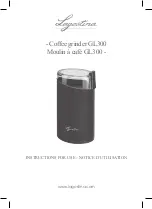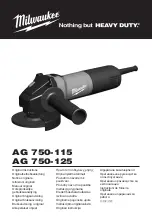
EN
51
the workpiece. Allow the disc to reach
maximum speed before it makes contact with
the workpiece.
Adjust the guard to cover as much of the disc
as possible.
Watch out for sparks when the disc comes into
contact with the workpiece.
The disc should be held at an angle of 15 to
30° to the surface of the workpiece for best
results.
Be extra careful on curves, corners and edges
etc. – risk of kickback.
Allow the workpiece to cool after grinding.
FIG. 15
TIPS
1. Start the product and allow it to reach
maximum speed before the disc makes
contact with the workpiece.
2. Do not press the disc against the
workpiece so hard that it slows down –
this results in overloading and slows down
the work.
3. Hold the grinding disc at an angle of 15 to
30° to the surface of the workpiece when
grinding. At a greater angle the disc will
cut furrows in the workpiece that reduce
the surface fineness. Move the grinding
disc smoothly backwards and forwards
over the surface of the workpiece.
4. When cutting, never attempt to change
the angle of the disc to the workpiece –
this can cause it to jam and can overload
the disc so that it shatters.
5. Feed the tool in the opposite direction
to the rotation of the disc when cutting.
Otherwise there is a risk that the disc will
be forced out of the cut.
6. Abrasive discs produce the best results
when cutting very hard materials.
7. These discs can get very hot when in use.
A ring of sparks around the disc is a sign
of a hot disc. If this happens, stop cutting
and run the tool with no load at full speed
for 2 to 3 minutes to cool the disc.
8. Secure the workpiece with a clamp, clips
or vice.
MAINTENANCE
Switch off the product, wait until all moving
parts have completely stopped and remove the
battery before adjusting, maintenance and/or
replacing accessories.
The product does not contain any parts that
can be repaired by the user. Do not use water
or detergent on the product. Wipe the product
with a dry cloth. Store the product in a dry
place. Keep the ventilation openings on the
motor clean. Keep the controls free from
dust. It is normal to see sparks through the
ventilation openings.
TROUBLESHOOTING
Follow the troubleshooting instructions below
in the event of any problems.
1. If the disc vibrates or kicks, check that the
spindle screw is tightened and that the
disc is correctly fitted on the spindle.
2. Replace the disc if it is damaged. Never
use damaged discs, they can shatter and
cause serious personal injury. Recycle
damaged discs in accordance with local
regulations.
3. When working with aluminium and other
soft metals and alloys the disc can quickly
become clogged and work less effectively.
4. Overloading can cause the disc to jam and
force the motor to stop. If this happens,
stop and run the tool with no load at full
speed for 30 seconds to cool the motor.
5. The product will not be overloaded if
Summary of Contents for 019801
Page 4: ...1 1 2 3 4 5 6 7 8 9 12 13 11 10 ...
Page 5: ...2 4 6 3 5 ...
Page 6: ...8 10 12 9 11 7 ...
Page 7: ...14 16 15 13 ...
















































